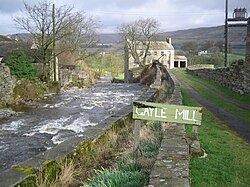Gayle Mill
| Gayle Mill | |
|
Yorkshire | |
|---|---|
 Gayle Mill | |
| Type: | Cotton mill |
| Location | |
| Grid reference: | SD87118938 |
| Location: | 54°17’60"N, 2°11’58"W |
| History | |
| Built 1784 | |
| Cotton mill | |
| Information | |
| Owned by: | Cultura Trust |
Gayle Mill, dating from about 1784, in the North Riding of Yorkshire is thought to be the oldest structurally unaltered cotton mill in existence.[1] It is located in the Wensleydale hamlet of Gayle, a mile south of the market town of Hawes. It is within the Yorkshire Dales National Park]].
The mill is owned by Cultura Trust (formerly known as the North of England Civic Trust); it was operated by a local volunteer group which paid a modest rent to the owner until March 2018 when the property was closed to enable additional repairs to be undertaken to make it safe for visitors.[2][3]
History

The Grade II* listed[4] mill was built by local hosiers and land owners Oswald and Thomas Routh as a water-powered cotton mill, and was powered by a 22 feet diameter overshot waterwheel. It was turned over to flax and wool spinning by 1813 for the local knitting industry. For a period in the 19th century, it was used for domestic accommodation.[5][6]
The mill was converted to a sawmill around 1879. The waterwheel was removed and replaced with a Thomson double-vortex turbine, built by Williamsons (now Gilbert Gilkes & Gordon Ltd) of Kendal. This is thought to be the only remaining working variety of its type.[4][7] In its heydey, the 10 hp (7.46 kW) created by the turbine drove a range of woodworking machinery – a rack sawbench, circular saw, thicknesser (planer), and lathes – by a series of belts and pulleys off a central line shaft.
In 1919, part of the mill was hired to provide electricity to the area using turbines for the generator.[8] The mill provided electricity for the village until 1948.[4] During the Second World War, soldiers from the Border Regiment and the Scots Guards were billeted in the top floor of the mill, and the millpond was used as a secret test location in the preparations for the Normandy landings.[9]
Restoration and current status
Gayle Mill closed in 1988, after over a century of operation as a sawmill, and it seemed likely it would be converted into luxury flats. In 2004 its plight came to national attention when it featured in the second series of BBC2's Restoration programme.[2] It won the regional heat and came in the top three in the national finals. Restoration of the mill started in the same year and works to bring the site to operational standard took four years and cost over £1 million.[10] Funding for the renovation came from several sources including the Heritage Lottery Fund, English Heritage and Yorkshire Forward.[3]
A Friends group was established from the local community and from that, with the assistance of the building owners (NECT) Gayle Mill Trust was formed. The Mill re-opened to the public in 2008, operated by Gayle Mill Trust.
In 2012 Gayle Mill was featured on Channel 4's How Britain Worked,[7] presented by Guy Martin.
The mill was operated as a centre for woodworking experience, providing training in traditional skills, a visitor attraction and an example of energy sustainability within the Yorkshire Dales National Park until March 2018.[11][12]
In April 2018 the building closed to the public as further work was required to make the building safer and easier to operate. Fundraising began and in 2020 refurbishment work started. In 2021 the building work was completed and the building reopened to the public on a part time basis with a new dedicated website - www.gaylemill.org
Outside links
| ("Wikimedia Commons" has material about Gayle Mill) |
- Gayle Mill
- Friends of Gayle Mill (supporters' group)
- English Heritage HELM programme case study of Gayle Mill
- Profile at the Forestry Commission
References
- ↑ "Industrial History of the Yorkshire Archaeological Society - YAS". Industrialhistory.yas.org.uk. 6 May 2006. http://www.industrialhistory.yas.org.uk/content/news066.html. Retrieved 10 March 2013.
- ↑ 2.0 2.1 "About Gayle Mill". Gayle Mill Trust. http://www.gaylemill.org.uk/about-gayle-mill. Retrieved 21 September 2020.
- ↑ 3.0 3.1 Willis, Joe (10 January 2018). "Gayle Mill to close just ten years after £1.2m restoration work". Richmondshire Today. http://www.richmondshiretoday.co.uk/gayle-mill-close-just-ten-years-1-2m-restoration-work/. Retrieved 21 September 2020.
- ↑ 4.0 4.1 4.2 National Heritage List 1132000: Gayle Mill (Grade II* listing)
- ↑ "Gayle Mill". Countysignpost.co.uk. 2 October 2010. http://www.countysignpost.co.uk/component/content/article/66-/643-gayle-mill?&tmpl=component. Retrieved 10 March 2013.
- ↑ "A landscape through time". Out of Oblivion. http://www.outofoblivion.org.uk/record.asp?id=243. Retrieved 10 March 2013.
- ↑ 7.0 7.1 "How Britain Worked - Clips - S1-Ep2: Mill". Channel 4. http://www.channel4.com/programmes/how-britain-worked/video/series-1/episode-2/s1-ep2-mill. Retrieved 10 March 2013.
- ↑ "Our Heritage". Archived from the original on 9 August 2015. https://web.archive.org/web/20150809114320/http://www.gaylemill.org.uk/our-heritage.
- ↑ "Gayle Mill | Hawes, Wensleydale | Eighteenth Century Working Sawmill & Heritage Site | Yorkshire Dales". http://www.gaylemill.org/.
- ↑ "Joy as historic mill reopens after £1m restoration (From Darlington and Stockton Times)". Darlingtonandstocktontimes.co.uk. 21 March 2008. http://www.darlingtonandstocktontimes.co.uk/news/2136871.joy_as_historic_mill_reopens_after_1m_restoration/. Retrieved 10 March 2013.
- ↑ "North Yorkshire | North of England Civic Trust". Nect.org.uk. Archived from the original on 26 August 2012. https://web.archive.org/web/20120826150409/http://www.nect.org.uk/projects/north-yorkshire. Retrieved 10 March 2013.
- ↑ "Countryside Apprentices Learn Traditional Skils". Ydmt.org. 4 May 2012. http://www.ydmt.org/news-details-countryside-apprentices-learn-traditional-skils-13995. Retrieved 10 March 2013.
- Giles, Colum and Goodall, Ian H (1992) Yorkshire Textile Mills 1770-1930, HMSO. ISBN 0-11-300038-3
- Ingle, George (1997) Yorkshire Cotton: The Yorkshire Cotton Industry, 1780-1835, Carnegie Publishing. ISBN 1-85936-028-9
